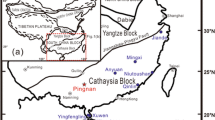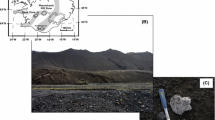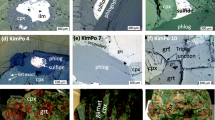Abstract
Hydrogen and oxygen isotope analyses have been made of hydrous minerals in gabbros and basaltic xenoliths from the Eocene Kap Edvard Holm intrusive complex of East Greenland. The analyzed samples are of three types: (1) primary igneous hornblendes and phlogopites that crystallized from partial melts of hydrothermally altered basaltic xenoliths, (2) primary igneous hornblendes that formed during late-magmatic recrystallization of layered gabbroic cumulates, and (3) secondary actinolite, epidote and chlorite that formed during subsolidus alteration of both xenoliths and gabbros. Secondary actinolite has a δ18O value of — 5.8‰ and a δD value of — 158‰. These low values reflect subsolidus alteration by low-δ18O, low-δD hydrothermal fluids of meteoric origin. The δD value is lower than the —146 to – 112‰ values previously reported for amphiboles from other early Tertiary meteoric-hy-drothermal systems in East Greenland and Scotland, indicating that the meteoric waters at Kap Edvard Holm were isotopically lighter than typical early Tertiary meteoric waters in the North Atlantic region. This probably reflects local climatic variations caused by formation of a major topographic dome at about the time of plutonism and hydrothermal activity. The calculated isotopic composition of the meteoric water is δD = - 110 ± 10‰, δ18O ≈ - 15‰. Igneous hornblendes and phlogopites from pegmatitic pods in horn-felsed basaltic xenoliths have δ18O values between- 6.0 and - 3.8‰ and δD values between - 155 and- 140‰. These are both much lower than typical values of fresh basalts. The oxygen isotope fractiona-tions between pegmatitic hornblendes and surrounding hornfelsic minerals are close to equilibrium fractiona-tions for magmatic temperatures, indicating that the pegmatites crystallized from low—δ18O partial melts of xenoliths that had been hydrothermally altered and depleted in 18O prior to stoping. The pegmatitic minerals may have crystallized with low primary δD values inherited from the altered country rocks, but these values were probably overprinted extensively by subsolidus isotopic exchange with low-δD meteoric-hydrothermal fluids. This exchange was facilitated by rapid self-diffusion of hydrogen through the crystal structures. Primary igneous hornblendes from the plutonic rocks have δ18O values between + 2.0 and + 3.2‰ and δD values between - 166 and - 146‰. The 18O fractionations between hornblendes and coexisting augites are close to equilibrium fractionations for magmatic temperatures, indicating that the hornblendes crystallized directly from the magma and subsequently underwent little or no oxygen exchange. The hornblendes may have crystallized with low primary δD values, due to contamination of the magma with altered xenolithic material, but the final δD values were probably controlled largely by subsolidus isotopic exchange. This inference is based partly on the observation that coexisting plagioclase has been extensively depleted in 18O via a mineral-fluid exchange reaction that is much slower than the hydrogen exchange reaction in hornblende. It is concluded that all hydrous minerals in the study area, whether igneous or secondary, have δD values that reflect extensive subsolidus isotopic equilibration with meteoric-hydrothermal fluids.
Similar content being viewed by others
References
Abbott D, Deer WA (1972) Geological investigations in East Greenland, Part X: the gabbro cumulates of the Kap Edvard Holm Lower Layered Series. Medd Groenl 190(6)
Bernstein S, Rosing MT, Brooks CK, Bird DK (1992) An ocean-ridge type magma chamber at a passive volcanic, continental margin: the Kap Edvard Holm layered gabbro complex, East Greenland. Geol Mag 129: 437–456
Bird DK, Manning CE, Rose NM (1988a) Mineralogic and isotopic constraints on the regional hydrology of the Skaergaard magma-hydrothermal system, East Greenland. Geol Soc Am Abstr Prog 20: A344.
Bird DK, Manning CE, Rose NM (1988b) Hydrothermal alteration of Tertiary layered gabbros, East Greenland. Am J Sci 288: 405–457.
Bott MHP (1987) The continental margin of central East Greenland in relation to North Atlantic plate tectonic evolution. J Geol Soc London 144: 561–568
Bottinga Y, Javoy M (1975) Oxygen isotope partitioning among the minerals in igneous and metamorphic rocks. Rev Geophys Space Phys 13: 401–418
Brandriss, ME (1993) Assimilation of metabasalt xenoliths and post-cumulus metasomatism of gabbros in the Kap Edvard Holm Complex, East Greenland. PhD dissertation, Stanford University
Brandriss ME, Bird DK, O’Neil JR (1992) Dependence of hydrotheral alteration on rock texture and microporosity in mafic crystalline rocks. In: Kharaka YK, Maest AS (eds) Proc 7th international symposium on water-rock interaction, vol 2: moderate and high temperature environments. AA Balkema, Rotterdam, pp 1477–1480
Brooks CK (1979) Geomorphological observations at Kangerdlug-ssuaq, East Greenland. Medd Groenl, Geoscience 1
Brooks CK (1985) Vertical crustal movements in the Tertiary of central East Greenland: a continental margin at a hot-spot. Z Geomorphol, Supplementband 54: 101–117
Clayton RN, Mayeda TK (1963) The use of bromine pentafluoride in the extraction of oxygen from oxides and silicates for isotopic analysis. Geochim Cosmochim Acta 27: 43–52
Cole DR, Ohmoto H (1986) Kinetics of isotope exchange at elevated temperatures and pressures. In: Valley JW, Taylor HPJr, O’Neil JR (eds) Stable isotopes in high temperature geological processes (Reviews in Mineralogy vol. 16) Mineralogical Society of America, Washington DC, pp 41–90
Cole DR, Ohmoto H, Lasaga AC (1983) Isotopic exchange in mineral-fluid systems. I. Theoretical evaluation of oxygen isotopic exchange accompanying surface reactions and diffusion. Geochim Cosmochim Acta 47: 1681–1693
Craig H (1961) Isotopic variations in meteoric waters. Science 133: 1702–1703
Crank J (1975) The mathematics of diffusion. Clarendon Press, Oxford
Criss RE, Taylor HPJr (1986) Meteoric-hydrothermal systems. In: Valley JW, Taylor HPJr, O’Neil JR (eds) Stable isotopes in high temperature geological processes (Reviews in Mineralogy vol. 16) Mineralogical Society of America, Washington DC, pp 373–424
Dansgaard W (1964) Stable isotopes in precipitation. Tellus 16: 436–468
Deer WA, Abbott D (1965) Clinopyroxenes of the gabbro cumulates of the Kap Edvard Holm complex, East Greenland. Mineral Mag, Tilley volume: 177–193
Deer WA, Kempe DRC, Jones GC (1984) Syenites and associated intrusions of the Kap Edvard Holm region of Kangerdlugssuaq, East Greenland. Medd Groenl, Geoscience 12
Elsdon R (1969) The structure and intrusive mechanism of the Kap Edvard Holm layered gabbro complex, East Greenland. Geol Mag 106: 46–56
Elsdon R (1972) Iron-titanium oxide minerals in the Upper Layered Series, Kap Edvard Holm Complex, East Greenland. Mineral Mag 38: 946–956
Farver JR, Giletti BJ (1985) Oxygen diffusion in amphiboles. Geochim Cosmochim Acta 49: 1403–1411
Farver JR, Giletti BJ (1989) Patterns and processes of oxygen isotope exchange in a fossil meteoric hydrothermal system, Cuillins gabbro complex, Isle of Skye, Scotland. Contrib Mineral Petrol 102: 24–33
Fehlhaber K, Bird DK (1991) Oxygen-isotope exchange and mineral alteration in gabbros of the Lower Layered Series, Kap Edvard Holm Complex, East Greenland. Geology 19: 819–822
Forester R, Taylor HPJr (1977)18O/16O, D/H, and 13C/12C studies of the Tertiary igneous complex of Skye, Scotland. Am J Sci 277: 137- 177
Forester RW, Taylor HPJr (1976) 18O-depleted rocks from the Tertiary complex of the Isle of Mull, Scotland. Earth Planet Sci Lett 32: 11–17
Fram MS (1994) Petrogenesis of the early Tertiary flood basalts of the East Greenland continental margin. PhD dissertation, Columbia University
Giletti BJ (1985) The nature of oxygen transport within minerals in the presence of hydrothermal water and the role of diffusion. Chem Geol 53: 197–206
Giletti BJ, Semet MP, Yund RA (1978) Studies in diffusion-III. Oxygen in feldspars: an ion microprobe determination. Geoch in Cosmochim Acta 42: 45–57
Gill RCO, Nielsen TFD, Brooks CK, Ingram GA (1988) Tertiary volcanism in the Kangerdlugssuaq region, E Greenland: trace-element geochemistry of the Lower Basalts and tholeiitic dyke swarms. In: Morton AC, Parsons LM (eds) Early Tertiary volcanism and the opening of the NE Atlantic. Geol Soc London Spec Pub 39: 161–179
Gleadow AJW, Brooks CK (1979) Fission track dating, thermal histories and tectonics of igneous intrusions in East Greenland. Contrib Mineral Petrol 71: 45 -60
Graham CM, Harmon RS, Sheppard SMF (1984) Experimental hydrogen isotope studies: hydrogen isotope exchange between amphibole and water. Am Mineral 69: 128–138
Gregory RT, Criss RE, Taylor HPJr (1989) Oxygen isotope exchange kinetics of mineral pairs in closed and open systems: applications to problems of hydrothermal alteration of igneous rocks and Precambrian iron formations. Chem Geol 75: 1–42
Holm PM (1988) Nd, Sr and Pb isotope geochemistry of the Lower Lavas, E Greenland Tertiary Igneous Province. In: Morton AC, Parsons LM (eds) Early Tertiary volcanism and the opening of the NE Atlantic. Geol Soc London Spec Pub 39: 181–195
Kyser TK (1986) Stable isotope variations in the mantle. In: Valley JW, Taylor HPJr, O’Neil JR (eds) Stable isotopes in high temperature geological processes (Reviews in Mineralogy vol. 16) Mineralogical Society of America, Washington DC, pp 141–164
Manning CE, Bird DK (1991) Porosity evolution and fluid flow in the basalts of the Skaergaard magma-hydrothermal system, East Greenland. Am J Sci 291: 201–257
Manning CE, Bird DK (1995) Porosity, permeability, and basalt metamorphism. In: Schiffman P, Day HW (eds) Low-grade meta-morphism of mafic rocks. Geol Soc Am Spec Pap 296: 123–140.
Manning CE, Ingebritsen SE, Bird DK (1993) Missing mineral zones in contact metamorphosed basalts. Am J Sci 293: 894–938
Matthews A, Goldsmith JR, Clayton RN (1983) Oxygen isotope fractionations involving pyroxenes: the calibration of mineral-pair geothermometers. Geochim Cosmochim Acta 47: 631–644
Mussett AE, Dagley P, Skelhorn RR (1988) Time and duration of activity in the British Tertiary Volcanic Province. In: Morton AC, Parsons LM (eds) Early Tertiary volcanism and the opening of the NE Atlantic. Geol Soc London Spec Pub 39: 337–348
Nevle RJ, Brandriss ME, Bird DK, McWilliams MO, O’Neil JR (1994) Tertiary plutons monitor climate change in East Greenland. Geology 22: 775–778
Nielsen TFD, Soper NJ, Brooks CK, Faller AM, Higgins AC, Matthews, DW (1981) The pre-basaltic sediments and the Lower Basalts at Kangerdlugssuaq, East Greenland: their stratigraphy, lithology, palaeomagnetism and petrology. Medd Groenl, Geo-science6
Noble RH, Macintyre RM, Brown PE (1988) Age constraints on Atlantik evolution: timing of magmatic activity along the E Greenland continental margin. In: Morton AC, Parsons LM (eds) Early Tertiary volcanism and the opening of the NE Atlantic. Geol Soc London Spec Pub 39: 201–214
O’Neil JR, Taylor HPJr (1967) The oxygen isotope and cation exchange chemistry of feldspars. Am Mineral 52: 1414–1437
Rose NM (1989) Geochemistry of hydrothermal metasomatism in basaltic systems. PhD dissertation, Stanford University
Sheppard SMF, Brown PE, Chambers AD (1977) The Lilloise intrusion, East Greenland: evidence for the efflux of magmatic water into the contact metamorphic aureole. Contrib Mineral Petrol 63: 129–147
Snyder RL, Bish DL (1989) Quantitative analysis. In:Bish DL, Post JE (eds) Modern powder diffraction (Reviews in Mineralogy vol. 20) Mineralogical Society of America, Washington DC, pp 101–144
Soper NJ, Downie C, Higgins AC, Costa LI (1976) Biostratigraphic ages of the Tertiary basalts on the East Greenland continental margin and their relationship to plate separation in the Northeast Atlantic. Earth Planet Sci Lett 32: 149–157
Suzuoki T, Epstein S (1976) Hydrogen isotope fractionations between OH bearing minerals and water. Geochim Cosmochim Acta 40: 12291240
Taylor HPJr (1974) The application of oxygen and hydrogen isotope studies to problems of hydrothermal alteration and ore deposition. Econ Geol 69: 843–883
Taylor HPJr (1977) Water/rock interactions and the origin of H2O in granitic batholiths. J Geol Soc London 133: 509 558
Taylor HPJr, Forester RW (1971) Low-18O igneous rocks from the intrusive complexes of Skye, Mull, and Ardnamurchan, Western Scotland. J Petrol 12: 465–497.
Taylor HPJr, Forester RW (1979) An oxygen and hydrogen isotope study of the Skaergaard intrusion and its country rocks: a description of a 55 m.y. old fossil hydrothermal system. J Petrol 20: 355–419
Vennemann TW, O’Neil JR (1993) A simple and inexpensive method of hydrogen isotope and water analyses of minerals and rocks based on zinc reagent. Chem Geol 103: 227–234
Wilson AD (1955) Determination of ferrous iron in rocks and minerals. Bull Geol Surv GB 9: 56–58
Yurtsever Y, Gat JR (1981) Atmospheric waters. In: Gat JR, Gonfiantini R (eds) Stable isotope hydrology, deuterium and oxygen-18 in the water cycle. International Atomic Energy Agency Technical Reports Series 210, Vienna, pp 103–142
Author information
Authors and Affiliations
Additional information
Editorial responsibility: T. L. Grove
Rights and permissions
About this article
Cite this article
Brandriss, M.E., Nevle, R.J., Bird, D.K. et al. Imprint of meteoric water on the stable isotope compositions of igneous and secondary minerals, Kap Edvard Holm Complex, East Greenland. Contrib Mineral Petrol 121, 74–86 (1995). https://doi.org/10.1007/s004100050090
Received:
Accepted:
Issue Date:
DOI: https://doi.org/10.1007/s004100050090




